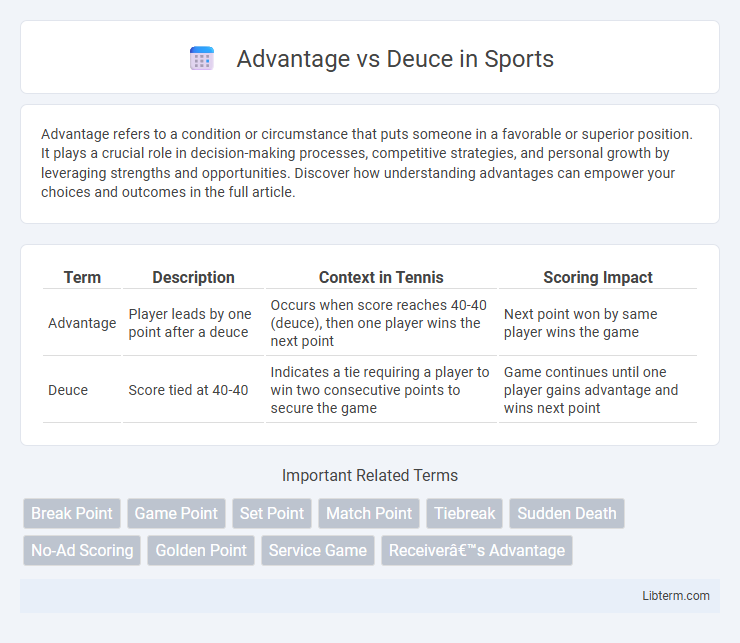Advantage refers to a condition or circumstance that puts someone in a favorable or superior position. It plays a crucial role in decision-making processes, competitive strategies, and personal growth by leveraging strengths and opportunities. Discover how understanding advantages can empower your choices and outcomes in the full article.
Table of Comparison
| Term | Description | Context in Tennis | Scoring Impact |
|---|---|---|---|
| Advantage | Player leads by one point after a deuce | Occurs when score reaches 40-40 (deuce), then one player wins the next point | Next point won by same player wins the game |
| Deuce | Score tied at 40-40 | Indicates a tie requiring a player to win two consecutive points to secure the game | Game continues until one player gains advantage and wins next point |
Understanding Advantage and Deuce in Tennis
Advantage and Deuce in tennis refer to critical scoring points during a game tied at 40-40, known as deuce. When a player wins the next point after deuce, they gain the advantage, meaning they need just one more point to win the game. If the player with the advantage loses the subsequent point, the score returns to deuce, emphasizing the importance of maintaining focus and consistency during these pivotal moments.
The Origin of Advantage and Deuce Scoring
Advantage and Deuce scoring originated from the traditional scoring system in tennis, evolving to ensure a clear winner by requiring a two-point lead after a 40-40 tie. The term "Deuce" stems from the French word "deux," meaning two, indicating the need for a player to score two consecutive points to win a game. "Advantage" reflects the first point gained after Deuce, highlighting a player's lead before potentially securing the game-winning point.
How Deuce Influences Tennis Match Dynamics
Deuce introduces critical tension and strategic depth by requiring a player to win two consecutive points to secure a game, significantly impacting momentum shifts during tennis matches. This scoring scenario forces competitors to sustain heightened focus and stamina, often revealing mental resilience and composure under pressure. The repeated exchanges at deuce can extend game duration, influencing overall match pacing and player endurance.
Psychological Impact of Reaching Deuce
Reaching deuce in tennis often intensifies the psychological pressure on both players as it signifies a critical turning point where momentum can shift dramatically. The mental resilience of players is tested, highlighting their ability to maintain focus, manage nerves, and execute strategies under increased stress. This psychological impact can influence subsequent points, making the advantage phase a true battle of mental strength and composure.
The Role of Advantage in Competitive Play
In competitive tennis, the Advantage rule plays a crucial role by allowing a player to gain a one-point lead after the score reaches deuce (40-40), thereby creating a decisive moment that tests mental toughness and skill under pressure. This break from the traditional no-advantage scoring system emphasizes strategic serving and return plays to secure the critical point necessary to win the game. The presence of Advantage scoring often extends match duration and intensifies competition, as players must consecutively win points rather than simply breaking a tie.
Strategies for Winning from Deuce
Winning from deuce in tennis requires strategic play focusing on high-percentage shots and mental resilience. Players often use serve placement and aggressive baseline rallies to pressure opponents and create opportunities to win the advantage point. Prioritizing first serve accuracy and exploiting opponent weaknesses increases the likelihood of converting from deuce to advantage.
Advantage vs Deuce: Key Differences
Advantage and Deuce are critical terms in tennis scoring, with Deuce indicating a tie at 40-40, requiring a player to win two consecutive points to secure the game. The key difference lies in the subsequent point after Deuce; if a player wins the next point, they gain the Advantage, representing a one-point lead. Unlike Deuce, where the score is tied, the Advantage state demands the leading player to win the very next point to clinch the game, or else the score returns to Deuce.
Common Mistakes Players Make at Deuce
Players often mismanage their positioning and shot selection at deuce, leading to lost opportunities despite the critical stage of the game. A frequent error is rushing to finish the point rather than maintaining consistent pressure through strategic placement and forcing opponents into errors. Understanding the importance of patience and mental focus during advantage versus deuce scenarios can significantly improve match outcomes.
Training Drills for Mastering Advantage Situations
Training drills targeting advantage situations emphasize replicating pressure scenarios to enhance decision-making speed and shot accuracy during crucial points. Players practice transition exercises involving alternating advantage and deuce points to improve mental resilience and strategic shot placement under stress. Incorporating video analysis and situational role-play drills further refines reflexes and tactical responses specific to maintaining or recovering advantage in competitive matches.
Case Studies: Famous Matches Decided at Deuce
Famous matches such as the 2008 Wimbledon final between Rafael Nadal and Roger Federer illustrate the intense pressure and strategic depth at deuce points, where each rally can shift momentum dramatically. Case studies reveal that players who maintain composure and apply precise shot selection during deuce often gain psychological leverage, altering the match's outcome. Analysis of these high-stakes moments highlights the critical role of mental toughness and tactical adaptability in clinching victory at deuce.
Advantage Infographic

 libterm.com
libterm.com